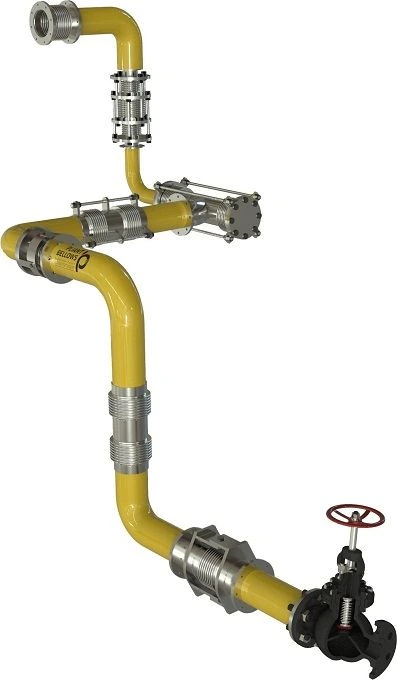METAL BELLOWS MANUFACTURER
Metal expansion joints (MEJ) also called compensators or metallic Bellows or metal bellows. An expansion joint/bellow element employed in a piping system is an assembly of generally more than one convolute in series with the shape of the convolution designed to withstand the internal pressures, Thermal expansion, mechanical vibrations of pumps, draft fans, compressors, turbines, motors, vessels and other plant components, but flexible enough to accept axial, lateral, and angular deflections. They consist of one or more metal bellows. Metal expansion joints have to be designed according to rules laid out by EJMA (expansion joint manufacturing association).For Fabric & Rubber expansion joints there are guidelines and a state-of-the-art description by FSA (fluid sealing association). Expansion joints are differentiated according to the three basic types of movement: axial, angular and lateral expansion joints. The central component of each expansion joint is the metal bellows. Due to its shape and thin wall, acts like a spring. The metal bellows however has to meet the following basic criteria to qualify for its use as an expansion element.
It must :
• Withstand the operating and test conditions (pressure, temperature).
• Ensure corrosion resistance.
• Provide sufficient flexibility for the purpose.
• Include sufficient squirm stability.
MOVEMENTS & SPRING RATES:
There are four basic movements that can be applied to a metal bellows. These are Axial, Lateral, Angular and Tensional. Respective spring rates are - Axial spring rate, Lateral spring rate, Angular spring rate. The spring rate of a metal bellows is entirely dependent on metal bellows geometry and material properties.
AXIAL MOVEMENT (+/‐ MM):
Axial movement is the change in dimensional length of the metal bellows from its free length in a direction parallel to its longitudinal axis. Compression is always expressed as negative (‐) and extension as positive (+). The units for axial spring rates displayed in N/mm.
LATERAL MOVEMENT (+/‐ MM):
This relative displacement of the two ends of an Expansion Joint perpendicular to its longitudinal axis. This has been referred to as lateral offset, lateral movement, parallel misalignment, direct shear or transverse movement.
ANGULAR MOVEMENT (+/‐ DEGREES):
This displacement of the longitudinal axis of the Expansion Joint from its initial straight line position into a circular arc.
TYPES OF EXPANSION JOINTS:
- • Axial Expansion Joint
- • Lateral Expansion Joint
- • Hinge Expansion Joint
- • Gimbal Expansion Joint
- • Inline Pressure Balanced Expansion Joint
- • Elbow Pressure Balanced Expansion Joint
- • Externally Pressurized Expansion joint
- • Two ply testable bellow
- • Rectangular Expansion Joint
- • Slip Type Expansion Joint
Metal Bellows

Services
- Metallic Expansion Bellows
- Bellows Couplings
- Bellow Valves
- Metal Expansion Joints
- Pressure Switch Bellows
- Axial Expansion Joints
- Lateral Expansion Joints
- Hinged Expansion Joints
- Universal Expansion Joints
- Gimbal Expansion Joints
- Inline Pressure Balanced Expansion Joints
- Elbow Pressure Balanced Expansion Joints
- Cummins Engine Bellows
Address
- Phone:
- +91-7028997949
- Phone:
- +91-9890977244
- Phone:
- +91-9890454224
- Address:
- Final plot no.38/1 Ramtekdi Industrial Estate Hadapsar, Pune - 411013, India
- E-mail:
- mktg@pliantbellows.com
- E-mail:
- anand.uttarkar@pliantbellows.com
